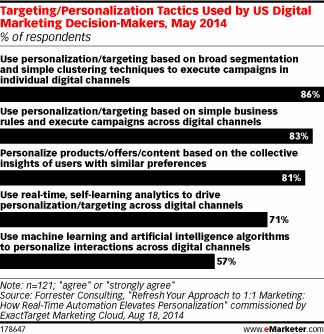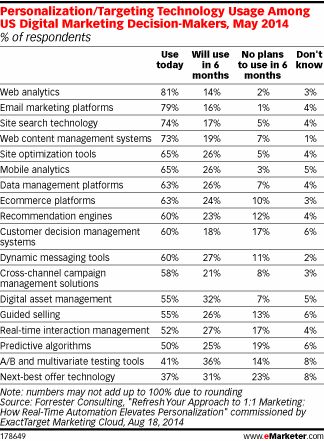Trends change within marketing all the time, and one that’s currently hot right now is personalization, as a lot of marketers are using data to create a viewpoint that customers can relate to. However, that doesn’t necessarily mean that everyone’s on board just yet.
A May 2014 study provided by Forrester Consulting (commissioned through ExactTarget Marketing Cloud) indicates that, despite the growth in interest in personalization, it’s still rather small, with just 18 percent of U.S. digital marketing decision-makers working to create a personalized customer experience across digital touchpoints as a general goal.

As you can see by the chart, there are some who would consider using certain ideas when it comes to targeting and personalization tactics. 86 percent feel that using personalization and targeting based on broad segmentation and simple clustering techniques to execute campaigns in individual digital channels would be ideal. Closely behind with 83 percent is the idea that it can be used with simple business rules, and campaigns can be executed across digital channels.
However, some tools still need to be firmly grasped when it comes to personalization, such as self-learning analytics that work in real time, machine learning and artificial intelligence algorithms. Not everyone, it seems, is ready for those tools just yet — but there’s no better time to learn.
The main hurdle is that some execs feel that these technologies aren’t the best when it comes to real-time targeting and making decisions. They fall behind when compared to web analytics and email marketing, sitting on the wayside next to the likes of A/B and multivariate testing tools and next-best offer technology.
Technology does create challenges for marketers, according to a supplementary poll from Experian Data Quality. These challenges emerge when it comes to making a single customer view that creates a representation of the data known by an organization. With the poll, 40 percent of those asked (which includes 24 percent of US data management professionals) believe that the inability to link different technologies together is the biggest challenge, followed by poor data quality and a lack of relevant technology.

It’ll be interesting to see if marketing folks change with the times. It never hurts to evolve a little.
Source: eMarketer

